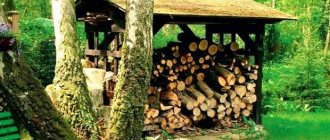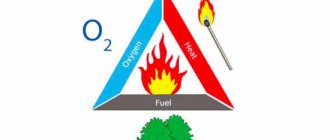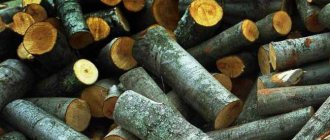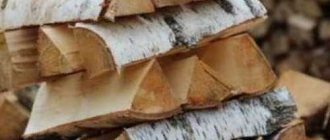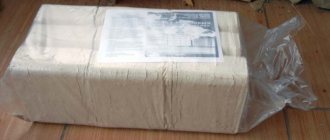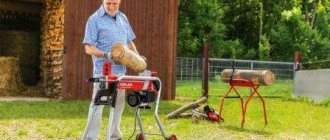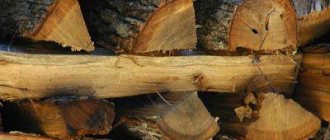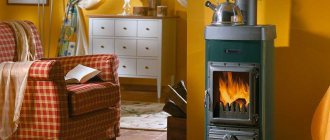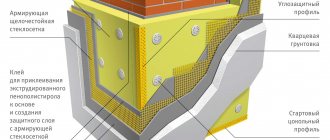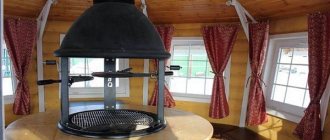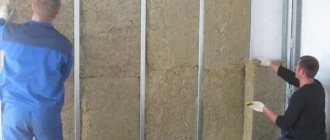Wood is a rather complex material in its chemical composition.
calorific value of firewood
Why are we interested in chemical composition? But combustion (including the burning of wood in a stove) is a chemical reaction of wood materials with oxygen from the surrounding air. The calorific value of firewood depends on the chemical composition of a particular type of wood.
The main chemical binders in wood are lignin and cellulose. They form cells - peculiar containers, inside of which there is moisture and air. Wood also contains resin, proteins, tannins and other chemical ingredients.
What determines the calorific value of firewood?
The chemical composition of the vast majority of wood species is almost the same. Small fluctuations in the chemical composition of different species determine the differences in the calorific value of different types of wood. Calorific value is measured in kilocalories - that is, the amount of heat obtained by burning one kilogram of wood of a particular species is calculated. There are no fundamental differences between the calorific values of different types of wood. And for everyday purposes it is enough to know the average values.
calorific value of various rocks
Differences between rocks in calorific value appear to be minimal. It is worth noting that, based on the table, it may seem that it is more profitable to buy firewood prepared from coniferous wood, because their calorific value is higher. However, on the market, firewood is supplied by volume, not by weight, so there will simply be more of it in one cubic meter of firewood harvested from deciduous wood.
Harmful impurities in wood
During the chemical combustion reaction, wood does not burn completely. After combustion, ash remains - that is, the unburnt part of the wood, and during the combustion process, moisture evaporates from the wood.
Ash has less effect on the combustion quality and calorific value of firewood. Its amount in any wood is the same and is about 1 percent.
But the moisture in wood can cause a lot of problems when burning it. So, immediately after cutting, wood can contain up to 50 percent moisture. Accordingly, when burning such firewood, the lion's share of the energy released with the flame can be spent simply on the evaporation of the wood moisture itself, without doing any useful work.
calorific value calculation
Moisture present in wood sharply reduces the calorific value of any firewood. Burning wood not only does not perform its function, but also becomes unable to maintain the required temperature during combustion. At the same time, the organic matter in the firewood does not burn completely; when such firewood burns, a large amount of smoke is released, which pollutes both the chimney and the combustion space.
What is wood moisture content and what does it affect?
A physical quantity that describes the relative amount of water contained in wood is called moisture content. Wood moisture content is measured as a percentage.
When measuring, two types of humidity can be taken into account:
- Absolute humidity is the amount of moisture that is currently contained in wood relative to completely dried wood. Such measurements are usually carried out for construction purposes.
- Relative humidity is the amount of moisture that the wood currently contains in relation to its own weight. Such calculations are made for wood used as fuel.
So, if it is written that wood has a relative humidity of 60%, then its absolute humidity will be expressed as 150%.
To calculate the calorific value of firewood at a known humidity, you can use the following formula:
Analyzing this formula, it can be established that firewood harvested from coniferous trees with a relative humidity of 12 percent will release 3940 kilocalories when burning 1 kilogram, and firewood harvested from deciduous trees with comparable humidity will release 3852 kilocalories.
To understand what a relative humidity of 12 percent is, let us explain that firewood acquires such humidity when it is dried outside for a long time.
Production and use of wood fuel
This material belongs to a separate category, since it is not mined, but made in special furnaces. Craftsmen burn pre-prepared wood in large combustion chambers, which allows them to change the structure of the fuel and remove all excess moisture from it. The basic technology for producing an effective coolant has been known since ancient times. In the old days, people burned wood blanks in special deep pits, blocking access to oxygen. Modern technologies have made great strides, thanks to which multifunctional charcoal kilns are available to craftsmen.
Provided that the finished coals are stored in suitable conditions, their moisture level does not exceed 16%. Ignition of fuel is observed when heated to 200˚C. The specific heat is at a fairly high level - 7400 kcal/kg. Experts note the fact that the combustion temperature of such coal largely depends on the combustion conditions and the type of wood. For example, birch-based fuel is excellent for heating a special forge, as well as for forging metal.
If the air is supplied intensively enough, the coal will burn at a temperature of 1250˚C. As for conventional stoves and boilers, this figure will be within 900˚C. But in a barbecue, charcoal burns well at a temperature of 700˚C.
In addition to high heat transfer, this material is characterized by low ash content. Numerous positive characteristics and an affordable price have influenced the fact that charcoal is actively used for frying aromatic meat on the grill, for fireplace heating, and also for preparing delicious dishes in ovens.
Features of charcoal kilns
Those devices that heat the room using coal have their own functional and design differences. Despite the high popularity of charcoal, not everyone knows that this material does not belong to the category of minerals, but was invented by man. The combustion temperature of this fuel is 900°C, due to which a sufficient amount of heat is released.
The production of charcoal is based on specific processing of wood, due to which its structure changes and excess moisture is removed. To implement such ideas, special ovens are used, the operating principle of which is based on pyrolysis.
Such units consist of four main elements:
- Chimney.
- Capacious combustion chamber.
- Special compartment for recycling.
- Strengthened base.
Read more: DIY chimney.
Manufacturing process
When the firewood is loaded into a special chamber, then the gradual smoldering of the firewood begins. This process occurs due to the presence of a large amount of oxygen gas in the firebox, which continuously supports combustion. During this procedure, a sufficient amount of heat is released, and all excess liquid turns into steam.
All the smoke generated goes into the recycling compartment, where it burns completely and releases heat. Such a versatile charcoal kiln can perform several tasks simultaneously. Thus, with its help, high-quality charcoal is produced, and a comfortable temperature for humans is maintained in the room itself.
Experts say that the process of making such fuel is very delicate, since the slightest inattention can lead to complete combustion of the wood. The worker must promptly remove already charred workpieces from the oven.
Density of wood and its effect on calorific value
In addition to moisture content, another factor affects the calorific value of firewood, namely density. This is a common physical quantity that shows how much weight a substance has per standard volume (usually per cubic meter).
To estimate calorific value, you need to use a slightly different characteristic, namely specific calorific value, which is a value derived from density and calorific value.
Information on the specific calorific value of certain wood species was obtained experimentally. The information is given for the same humidity level of 12 percent. Based on the results of the experiment, the following table :
specific calorific value
Using the data from this table you can easily compare the calorific value of different types of wood.
The essence of the combustion process
If you heat wood, at 120–150 ˚C it becomes dark in color. This is a slow charring, turning into charcoal. Raising the temperature to 350–350 ˚С, we will see thermal decomposition, blackening with the release of white or brown smoke. When heated further, the released pyrolysis gases (CO and volatile hydrocarbons) will ignite, turning into flames. After burning for some time, the amount of volatile substances will decrease, and the coals will continue to burn, but without a flame. In practice, to ignite and maintain combustion, the wood must be heated to 450–650 ˚C.
https://youtube.com/watch?v=CWXiiIyC4XA
Wood burning process
Subsequently, the combustion temperature of heating oil in the firebox ranges from approximately 500 ˚С (poplar) to 1000 and higher (ash, beech). This value greatly depends on the draft, the design of the furnace and many other factors.
The color of wood when burning may change depending on the temperature
What kind of firewood can be used in Russia
Traditionally, the most favorite type of firewood for burning in brick kilns in Russia is birch. Although birch is essentially a weed, the seeds of which easily cling to any soil, it is extremely widely used in everyday life. An unpretentious and fast-growing tree has faithfully served our ancestors for many centuries.
Birch firewood has a relatively good calorific value and burns quite slowly and evenly, without overheating the stove. In addition, even the soot obtained from the combustion of birch firewood is used - it includes tar, which is used for both household and medicinal purposes.
In addition to birch, aspen, poplar and linden wood is used as deciduous wood as firewood. Their quality compared to birch, of course, is not very good, but in the absence of others, it is quite possible to use such firewood. In addition, linden firewood, when burned, releases a special aroma, which is considered beneficial.
Aspen firewood produces a high flame. They can be used at the final stage of the fire to burn off soot formed when burning other wood.
Alder also burns fairly smoothly, and after combustion it leaves a small amount of ash and soot. But again, in terms of the sum of all the quality, alder firewood cannot compete with birch firewood. But on the other hand - when used not in a bathhouse, but for cooking - alder firewood is very good. Their even burning helps to cook food efficiently, especially baked goods.
Firewood harvested from fruit trees is quite rare. Such firewood, and especially maple, burn very quickly and the flame reaches a very high temperature during combustion, which can negatively affect the condition of the stove. In addition, you just need to heat air and water in the bath, and not melt metal in it. When using such firewood, it must be mixed with firewood with low calorific value.
Firewood made from softwood is rarely used. Firstly, such wood is very often used for construction purposes, and secondly, the presence of a large amount of resin in coniferous trees pollutes fireboxes and chimneys. It makes sense to heat the stove with pine wood only after long-term drying.
Collection of problems in physics, Lukashik V.I.
1033. Which firewood - birch, pine or aspen - releases more heat upon complete combustion if they are all equally dried and their masses are equal? (The specific heat of combustion of aspen is about 1.3 • 107 J/kg.)
The specific heat of all these firewood is the same, so when they burn, the same amount of heat will be released.
1034. Is it possible to calculate how much heat will be released during the complete combustion of a pine log? If possible, how to do it, what do you need to know?
Can. To do this, you need to know the specific heat of combustion and the mass of the log.
1035. Calculate how much energy will be released during the complete combustion of charcoal weighing 15 kg; kerosene weighing 200 g.
1036. What amount of heat will be released during the complete combustion of gasoline weighing 5 kg; coal weighing 10 kg?
1037. What amount of heat will be released during the complete combustion of gunpowder weighing 25 g; peat weighing 0.5 tons; coal weighing 1.5 tons?
1038. How much heat will be released during the complete combustion of dry birch firewood with a volume of 5 m3?
1039. How much heat will be released during the complete combustion of kerosene with a volume of 0.25 m3; alcohol with a volume of 0.00005 m3; 25 liters of gasoline; 250 liters of oil?
1040. How much more heat will be released during the complete combustion of gasoline weighing 2 kg than during the combustion of dry birch firewood of the same mass?
1041. How many times more heat will be released during the complete combustion of hydrogen weighing 1 kg than during the complete combustion of dry birch firewood of the same mass?
1042. Gasoline weighing 2 kg and kerosene weighing 3 kg were mixed. How much heat will be released during complete combustion of the resulting fuel?
1043. Mixed 1.5 liters of gasoline and 0.5 liters of alcohol. How much heat will be released during complete combustion of this fuel?
1044. Dry pine firewood with a volume of 0.01 m3 and peat weighing 5 kg were burned in the oven. How much heat was released in the furnace?
1045. For winter, dry pine firewood with a volume of 2 m3 and coal weighing 1.5 tons were prepared. How much heat will be released in the stove when the fuel stored in it is completely burned?
1046. a) With the complete combustion of anthracite (solid fuel) weighing 10 kg, 2.9 • 107 J of energy is released. What is the specific heat of combustion of anthracite? b) In the elevator of a high-rise building at Moscow University, a student climbed with a sports load (4 sports hammers). To what height was the load raised if its potential energy relative to the floor of the first floor of the building became equivalent to the energy released during the complete combustion of 1 g of oil? (For cargo information, see table 17.)
1047. At what altitude above the surface of the ocean was a team of football players flying in an airplane at a time when the potential energy of their soccer ball in the airplane was equivalent to the amount of heat that is released during the complete combustion of 1 g of oil? (For the ball, see table 17.)
1048. How much coal needs to be burned to release 1.5 • 108 J of energy; 1.8 • 105 kJ of energy?
1049. Peat weighing 20 tons was burned in the furnace of a steam engine boiler. What mass of coal could replace the burnt peat? (The specific heat of combustion of peat is taken equal to 1.5 • 107 J/kg.)
1050. How much coal must be burned to obtain the same amount of energy as is released during the combustion of 6 m3 of gasoline?
1051. How much alcohol must be burned to change the temperature of water weighing 2 kg from 14 to 50 °C, if all the heat released during the combustion of alcohol is used to heat the water?
1052. How much water taken at a temperature of 14 °C can be heated to 50 °C by burning alcohol weighing 30 g and assuming that all the energy released during the combustion of alcohol goes to heating the water?
1053. How much will the temperature of water with a volume of 100 liters change if we assume that all the heat released when burning charcoal weighing 0.5 kg will be used to heat the water?
1054. How much will the temperature of water, whose mass is 22 kg, change if all the energy released during the combustion of kerosene, whose mass is 10 g, is transferred to it?
- Like
How to prepare firewood
Firewood collection usually begins in late autumn or early winter, before permanent snow cover is established. The felled trunks are left on the plots for initial drying. After some time, usually in winter or early spring, the firewood is removed from the forest. This is due to the fact that during this period no agricultural work is carried out and the frozen ground allows more weight to be loaded on the vehicle.
But this is the traditional order. Now, due to the high level of technological development, firewood can be prepared all year round. Enterprising people can bring you already sawn and chopped firewood any day for a reasonable fee.
How to saw and chop wood
Cut the brought log into pieces suitable for the size of your firebox. Afterwards, the resulting decks are split into logs. Logs with a cross-section of more than 200 centimeters are split with a cleaver, the rest with a regular axe.
The logs are split into logs so that the cross-section of the resulting log is about 80 sq.cm. Such firewood will burn for quite a long time in a sauna stove and produce more heat. Smaller logs are used for kindling.
woodpile
Chopped logs are stacked in a woodpile. It is intended not just for storing fuel, but also for drying firewood. A good woodpile will be located in an open space, blown by the wind, but under a canopy that protects the wood from precipitation.
The bottom row of woodpile logs is laid on logs - long poles that prevent the firewood from coming into contact with the wet soil.
Drying firewood to an acceptable humidity level takes about a year. In addition, wood in logs dries much faster than in logs. Chopped firewood reaches an acceptable humidity level within three months of summer. When dried for a year, the wood in the woodpile will have a moisture content of 15 percent, which is ideal for combustion.
